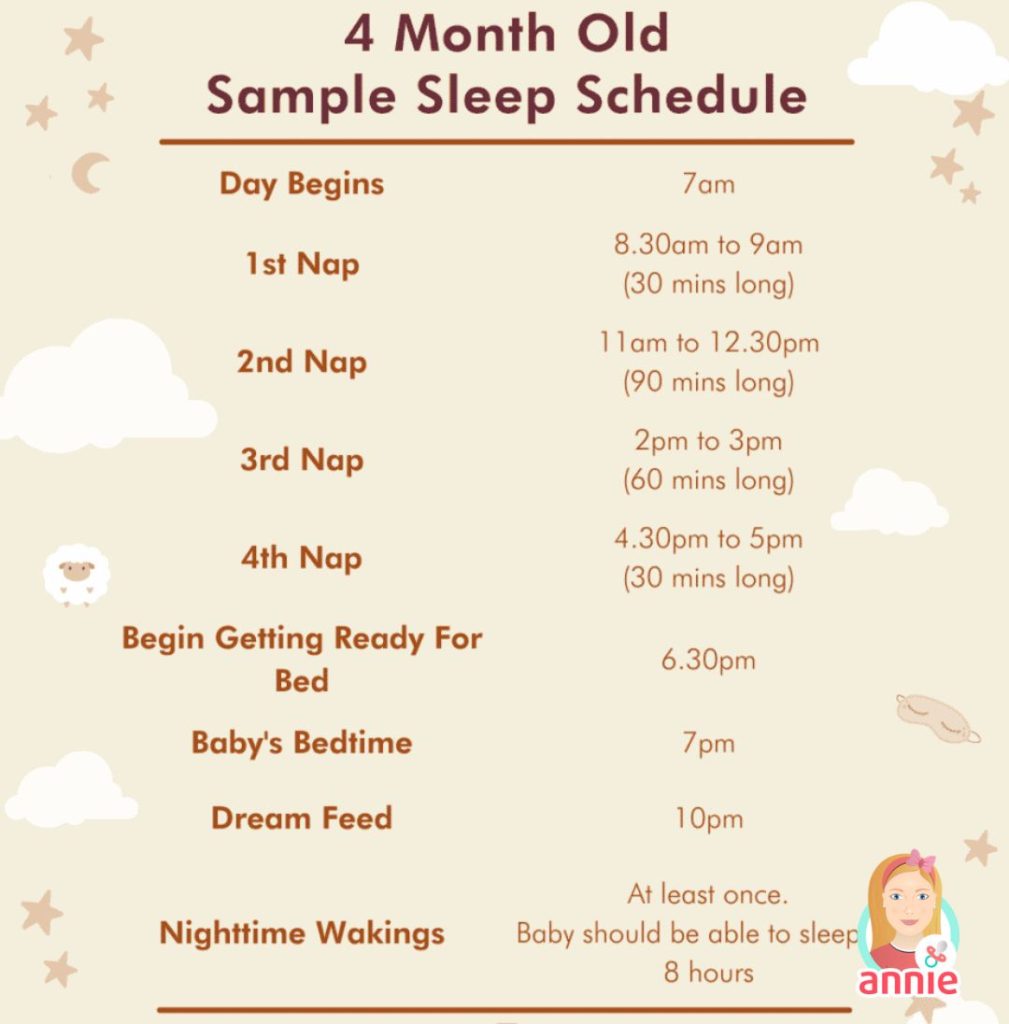
Sweet Dreams Ahead: A Comprehensive Guide to Managing Your 4-Month-Old Sleep Schedule
- Created:
10. 11. 2023 - Updated:
13. 11. 2023
Get this:
Sleep is not only crucial for your baby’s growth and development but also for your well-being.
Sadly:
As a parent of a 4-month-old, you’ve likely experienced the challenges of establishing a consistent sleep routine.
Don’t worry, you’re not alone!
In this article, we will discuss a step-by-step plan for creating a balanced 4-month-old sleep schedule. We’ll also explore the concept of sleep windows for a smoother sleep routine.
Let’s get to it!
The Importance of Sleep for a 4-Month-Old
Undoubtedly:
Sleep is an essential part of a 4-month-old’s life, facilitating their physical and mental development. It helps their body to repair and regenerate tissues with enough of it.
Sleep is equally important for cognitive development. According to the National Institute of Health, your baby’s brain is highly active during REM (Rapid Eye Movement) sleep. It helps them form and retain memories, as well as enhances learning and problem-solving abilities.
Furthermore:
Adequate sleep promotes healthy weight gain, muscle development, and overall physical well-being. It also supports mood and emotional regulation, fostering a happier and more contented baby.
So, how much sleep does a 4-month-old need?
On average:
A 4-month-old should sleep for about 12-16 hours per day. This includes daytime and nighttime sleep.
However:
Every child is unique, and their sleep requirement can vary. Therefore, creating a structured sleep routine and recognizing your baby’s sleep patterns can go a long way in providing the quality sleep they need.
Now:
Let’s take a look at sleep windows and how they influence your infant’s sleep schedule.
Identifying Sleep Windows
Listen:
One of the essential keys to establishing a successful sleep routine for your 4-month-old is recognizing your child’s sleep window.
These windows signify the perfect moments when your baby is naturally inclined to fall asleep. It simplifies the process of easing them into a restful slumber.
As such, missing this precious window can lead to an overtired, fussy baby, making their sleep and yours difficult.
Now:
You can identify obvious sleep windows with the following signs:
- Continuous yawning
- Droopy eyes
- Clinginess
- Fussiness or Irritability
- Decreased alertness and interest in surroundings
Get this:
Whether you’re a new parent or not, understanding how to handle these could be a game changer for you and your little one.
First off:
Pay close attention to your baby’s behavior and body language, like the ones above. These are early indicators that your baby is getting sleepy. So, recognizing these signs and acting promptly can help you prepare for their nap or bedtime.
Also:
Establish a predictable and consistent sleep routine for your baby. Babies tend to follow a schedule when it comes to naps and sleep.
So:
Knowing your baby’s awake and nap times can help you anticipate when their sleep window is approaching.
Additionally:
Create a calm sleep environment by dimming lights and reducing noise. You can engage in soothing pre-sleep activities like a warm bath or a gentle lullaby.
Lastly:
Keep a sleep log or diary to help you identify trends in your baby’s sleep habits. This can be a valuable tool for recognizing their sleep windows.
Note:
While routine is essential, it’s also important to be flexible. Babies’ sleep patterns can change, so be prepared to adapt your routine as your baby grows.
Pay attention to their cues!
Creating a 4-Month-Old Sleep Schedule: Step-by-Step Guide
It’s no news:
Establishing a consistent sleep routine is one of the most significant challenges in the early months of a baby’s life.
Now:
At four months old, your baby’s sleep patterns are gradually maturing, making it the perfect time to establish a structured daily sleep routine.
A well-structured sleep routine can make a lot of difference. It significantly enhances your baby’s well-being and sleep quality.
Thankfully, we have provided a step-by-step guide to help you through the process of creating a balanced sleep schedule for your 4-month-old.
Let’s begin!
Observe Your Baby’s Natural Rhythms
Get this:
To create an efficient sleep plan for your 4-month-old, you must first understand their natural sleep rhythms.
Babies, just like adults, have their own sleep and wake cycles. Therefore, recognizing these cues is essential in creating an optimal sleep routine.
Again:
It’s important to pay close attention to observe tell-tale signs like frequent yawning, rubbing their eyes, or increased fussiness.
These are clear indicators that your baby is growing exhausted and ready for sleep.
To make tracking easier:
Use diaries or sleep journals to note your baby’s sleep patterns and identify trends in their behavior.
By maintaining a record of their wake times, nap durations, and nighttime sleep, you can develop a sleep schedule that aligns with your baby’s unique sleep rhythms.
Establish a Bedtime Routine
Look:
A bedtime routine is a parent’s secret weapon for ensuring a good night’s sleep for their baby. This nightly ritual serves as a powerful signal to your little one that it’s time to wind down.
As we mentioned earlier:
Babies thrive on routines. And establishing a bedtime routine has a positive impact on sleep quality and duration.
Moreover:
A bedtime routine fosters a sense of security for your baby. Your baby learns to associate these bedtime cues with rest, ultimately leading to a more positive bedtime experience.
Therefore:
Parents and caregivers should prioritize soothing activities to help their babies relax and prepare for sleep.
We recommend starting with a warm bath and a gentle massage using a baby-friendly lotion. This helps soothe your baby’s muscles, eases tension, and prepares them for bedtime.
After that:
Consider playing lullabies or reading bedtime stories. This gives parents a perfect opportunity to bond with their babies.
Then:
Create a peaceful ambiance by dimming the lights in the room or nursery. Parents can also rock their babies gently. These swinging motions are incredibly soothing as they mimic the sensation of being in the womb.
In addition:
The use of white noise can help drown out background noises and provide a calm sensation for your baby.
Remember:
The key to a successful bedtime routine is consistency. By repeating the same activities each night, your baby will learn to associate them with bedtime, creating a sense of predictability and comfort.
Set a Consistent Wake Time
Fact:
Consistent wake time is as vital in shaping your 4-month-old’s sleep schedule as a bedtime routine. Certainly, waking up at the same time each day helps regulate your baby’s circadian rhythms.
According to the American Association of Pediatrics, the circadian rhythm is an internal clock that helps the body distinguish between day and night. And it usually develops between 1 and 3 months of age.
Now:
This regularity sends a powerful signal to your baby’s body, informing it that it’s time to start the day.
It helps align their natural sleep-wake cycle with the external world, making it easier for them to fall asleep at night and stay awake during the day.
As such:
Consistency in both bedtime and waketime routines provides predictability, which fosters a sense of security for your baby.
But remember:
As your baby grows, their sleep needs change. So maintaining consistency in waketime allows you to adapt to their evolving requirements, ensuring a smooth and well-balanced sleep schedule.
Plan Nap Times
To begin with:
Balancing daytime naps is a crucial aspect of your 4-month-old’s sleep schedule.
Now:
Proper nap planning involves creating a nap schedule that suits your baby’s age and needs. The aim is to help your baby achieve the optimal amount of daytime sleep without jeopardizing their nighttime sleep.
According to WebMD, a typical 4-month-old should nap for about three to four times a day. The duration changes from about 30 minutes to 2 hours, depending on your baby’s individual preference.
Clearly:
This recommended nap schedule prevents your baby from oversleeping during the day and further minimizes the likelihood of nighttime awakenings.
Include Time for Feedings
Obviously:
Feeding schedules are critical for a 4-month-old baby. According to Healthy Children, most babies need to be fed every 3-4 hours during the day.
In fact, at this age:
Babies typically consume 4-6 ounces every feeding, and can feed anywhere from five to seven times per day.
But how can you incorporate feeding times into your baby’s sleep schedule?
Simply start the day with a morning feeding after your baby wakes up. Also, plan to feed your baby before and after each nap to prevent hunger from interfering with their sleep.
Lastly:
Ensure to feed them once or twice at night so they don’t wake up the next morning hungry.
And that’s it!

Sample 4-Month-Old Sleep Schedule
Frankly:
As your baby reaches the 4-month mark, establishing a consistent sleep schedule should become a key focus for parents. A structured sleep routine can help both you and your baby enjoy more restful nights.
That being said:
We have prepared a sample 4-month-old sleep schedule that you can use as a template or inspiration.
However:
Every child is unique, so feel free to adjust this schedule to your baby’s individual needs and cues.
| Time | Activity |
|---|---|
| 7:00 AM | Wake and morning feeding |
| 8:30 AM | Morning nap |
| 10:00 AM | Mid-morning feeding |
| 11:30 AM | Mid-morning nap |
| 1:00 PM | Afternoon feeding |
| 2:30 PM | Afternoon nap |
| 4:00 PM | Late afternoon feeding |
| 5:30 PM | Cat nap |
| 7:00 PM | Bedtime routine and feeding |
| Nighttime | Be prepared for 1-2 nighttime feedings |
Final Tip: Annie Baby Monitor – Your Sleep Helper for Newborns
Babies and their sleeping habits can be quite puzzling!
But don’t worry, with Annie Baby Monitor’s baby tracking feature, you can keep an eye on your little one’s sleep patterns without any hassle.
Annie Baby Monitor baby tracker allows you to keep a watchful eye on your newborn’s sleep duration. By collecting and analyzing this valuable data, you can identify patterns and create a sleep routine that suits your baby’s needs.

So, if you’re navigating the newborn sleep, let Annie Baby Monitor be your trusted sleep helper.
Conclusion
All in all:
Sleep is crucial for a child’s physical and mental development as it fosters growth, memory retention, and physical well-being.
It also plays a vital role in their cognitive development, mood regulation, and overall emotional health.
Therefore:
Establishing a balanced sleep schedule for your 4-month-old is a crucial aspect of their growth and development. It is also instrumental in your well-being as a parent.
To create a sleep schedule for your 4-month-old, you can adopt the following tips.
- Observe your baby‘s natural rhythms
- Establish a bedtime routine
- Set a consistent wake time
- Plan nap times
- Include time for feedings
What’s more?
You can use our sample sleep schedule as a template when creating yours. Only ensure to tailor the schedule to your baby’s individual needs.
Finally: I trust you found this guide on creating a 4-month-old sleep schedule helpful. If you did, please share your thoughts and suggestions in the comments section below.






